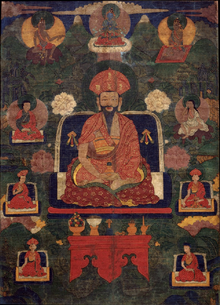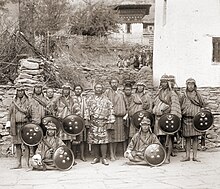Military history of Bhutan
Before Bhutan emerged as a separate nation, it remained on the periphery of Tibetan military and political influence.
Bhutan effectively ceased all international military hostilities in 1865 under the Treaty of Sinchula after its defeat by the British Empire.
Bhutan has maintained this status with India under Bhutan–India relations since 1949 and has modernly engaged only in limited domestic operations against Indian separatist groups.
In 824, Tibetan King Tritsun Desten (r. 816–836), also called Raelpachen and grandson of Trisong Detsen, went to war with an Indian ruler in Bhutan, driving him out.
Tibetans sought refuge in Bhutan from ensuing political and religious upheaval during the reign of Langdharma (836–842).
[3][4] In the late 9th century, ethnic Tibetan forces expelled Indian princes from parts of modern Bhutan.
[6] The military history of Bhutan as a nation begins with warfare between founder Zhabdrung Ngawang Namgyal, himself a Tibetan refugee, and rulers of Tibet.
As Bhutan gained its own measure of regional power in the late 17th century, it invaded neighboring kingdoms in Sikkim, Cooch Behar, and the Duars.
[7] During times of crisis, the government raised militias from among local lords' retinues, all commanded by one dapon[what language is this?]
[12] In 1639, another attempted invasion by Karma Tenkyong failed, followed by a joint Mongol-Tibetan force in 1643 under Güshi Khan that sought to destroy Nyingmapa refugees who had fled to Bhutan, Sikkim, and Nepal.
The Mongols had seized control of religious and civil power in Tibet in the 1630s and established Gelugpa as the state religion.
[14] Many Bhutanese slaves during this period originated from Sikkim and the Assam Duars, objects of repeated raids by Bhutan over the centuries.
[15][16][17][18][19] A large number of these slaves were pressed into military service, and some went on to fill high posts in the Bhutanese armed forces.
In 1730, Cooch Behar first requested Bhutanese assistance in repelling Mughal Empire encroachments, establishing a dependent relationship with Bhutan.
In 1841, the British annexed the Bhutanese controlled Assam Duars, paying a compensation of 10,000 rupees a year to Bhutan.
The British responded by withholding all compensation payments and demanding release of all captives and return of stolen property.
[7] In 1864, Britain sent a peace mission to Bhutan in the wake of a recent civil war, during a period when two rival claimants to the office of Druk Desi competed for power.
"[25] In 1943, the Kingdom of Bhutan began to raise its first organized an army at Trongsa, recruiting 30 Kheng troops from Mongar.
During the late 1940s, the second King of Bhutan, Jigme Wangchuck, began sending recruits for training by the Indian Army in Shillong.
[40] Project DANTAK of the Border Roads Organisation, a sub-division of the Indian Army Corps of Engineers, has been operating in Bhutan since May 1961.
Since then, Project DANTAK has been responsible for the construction and maintenance of over 1,500 km of roads and bridges, Paro Airport and a disused airfield at Yangphula, heliports, and other infrastructure.
The Kingdom of Bhutan has engaged solely in domestic combat operations against Indian separatist groups during the winter of 2003–2004.
Secessionist militant groups active in India, having established bases in southern Bhutan, defied an ultimatum to leave the kingdom.
With the support of the Indian Armed Forces, the Royal Bhutan Army engaged militant camps and eliminated them all in Operation All Clear.
During the early 1990s, Indian separatist groups, namely the United Liberation Front of Asom (ULFA), National Democratic Front of Bodoland (NDFB), and Kamtapur Liberation Organization (KLO), had begun to clandestinely set up camps in Bhutan's dense southern jungles.
The Royal Government preferring a peaceful solution, declined the offer and instead initiated dialogue with the militant groups in 1998.
Additionally, the RBA seized "more than 500 AK 47/56 assault rifles and 328 other assorted weapons including rocket launchers and mortars, along with more than 100,000 rounds of ammunition.
[47] A total of 485 ULFA, NDFB, and KLO militants were killed, while those captured along with seized weapons and ammunition were handed over to the Government of India.




